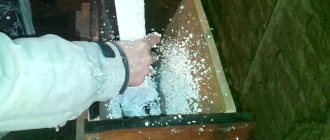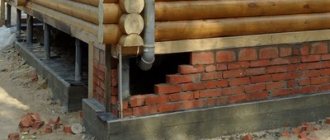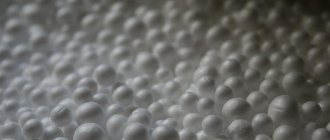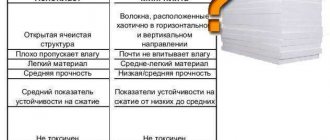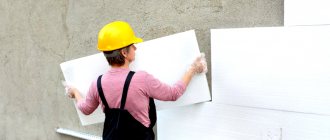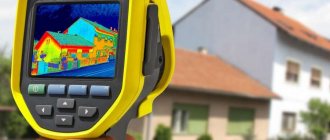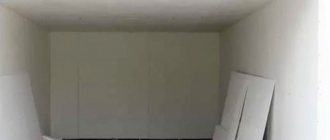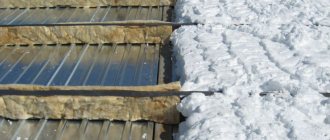Pros and cons of the material
Polystyrene foam is a foamed plastic material and therefore has a fairly low density. In modern times, it is a worthy alternative to gypsum.
Its positive properties:
- high thermal insulation;
- fireproof;
- lightweight, easy to install, process, and transport;
- not susceptible to damage by mold or parasites;
- repairable;
- suitable for wet areas;
- does not lose its appearance for a long time;
- good as insulation;
- suitable for decorating facades and interior decoration;
- withstands a wide temperature range;
- does not deteriorate when washed;
- very cheap.
Disadvantages of the material:
- many species are toxic;
- easily destroyed when exposed to certain paints, solvents, and alcohol;
- often damaged or broken during transportation and installation;
- It is impossible to make overly complex elements.
In interior design, all kinds of stucco moldings are made from polystyrene foam, as well as a variety of crafts, souvenirs, and decorations for the home and garden.
Stucco for walls
Imitation of gypsum stucco is made from large- and fine-grained sheets of foam plastic. Most often, such details are made white, unpainted or imitating various materials - wood, stone, etc. Stucco moldings made of polystyrene foam decorate the interiors of the following styles:
- Art Deco;
- classical;
- rococo;
- baroque;
- Empire;
- Renaissance;
- Greek;
- modern;
- romantic;
- modern.
The following decorative elements are produced to decorate polystyrene walls:
- plinth – covers the junction of the walls and the floor, plinths are produced in various thicknesses, can hide wires;
- cornice - covers the angle formed between the ceiling and the wall, comes in different widths and degrees of decorativeness;
- socket – frames the place where the lamp is attached;
- molding - a wide strip decorated with a three-dimensional pattern, used as a frame;
- bas-relief – a three-dimensional detail protruding above the plane, a full-fledged composition;
- bracket - attached to protruding parts as a supporting part, decorated with curls;
- corner parts - they are used to decorate the corners of the walls;
- column – a three-dimensional part, mounted vertically on the wall;
- semi-column - less convex than a column, usually rounded;
- capital - the upper part of a column, half-column;
- niche - attached to the wall, various objects are installed on it;
- fireplace element - frame for decorative or electric fireplace;
- sandrik – facade cornice above a window, rarely used indoors;
- framing elements of doors, windows, arches - have different sizes and shapes;
- architrave - may have a complex pattern, but more often it is a narrow part under which the wiring is hidden;
- panels - have the form of tiles with convex patterns of various sizes; the “brick” design is popular.
Elements for exterior decoration are reinforced with acrylic fiberglass mesh, onto which a special coating is applied, resulting in a completely realistic imitation of real plaster.
It is advisable to use foam stucco molding where it cannot be damaged by people or pets, since rough impact leaves dents on it, which greatly spoil the appearance.
Ceiling stucco
Polystyrene foam is lightweight, which is why it is used for finishing suspended, suspended, and ordinary ceilings. The following parts are used:
- decorative panels - square tiles, approximately 50 by 50 cm in size, with which the ceiling is completely covered, usually have convex parts;
- ceiling sockets - they are used to decorate the bases of lamps mounted on the ceiling;
- caissons - available in the form of textured rectangular and square tiles;
- domes - have the shape of round concave tiles;
- ornaments, including corner ones - details of different sizes in the form of flowers, curls, diamonds, attached to both the ceiling and walls;
- ceiling plinths - mounted between the ceiling and the wall, sometimes decorated with lighting.
To order, some companies produce entire ceiling and wall panels, stylized as the Renaissance era or with an image that the client wants.
When decorating with interior stucco, the main thing is not to “overdo it” with the decor - too much of it looks tasteless.
Manufacturing of cutting apparatus
We present to you a master class on making a cutting machine, the advantage of which is that it is not difficult to assemble it yourself. For assembly we prepare the following parts:
- Hardboard with ready-made holes that will be used for perforation;
- Aluminum oblong stick, half a meter long;
- Quick-setting adhesive;
- Alligator clips from wires;
- Wooden bars, diameter up to 7 cm;
- Cardboard;
- Scotch;
- Working power supply;
- Nichrome thread, bolts and nuts, screws, nails.
So, let's start assembling the device itself. First, make a hardboard base. The edge should not be more than 45 cm. The hardboard is attached to the wooden blocks with self-tapping screws. The bars are the legs of the installation.
In one block we drill a hole for an aluminum rod, which is bent 30 cm from the beginning into a 90-degree angle.
A rod is inserted into the block. On a hardboard base, we mark the place closest to the second end of the rod. The rod is cut above this mark. To prevent it from rotating, a nail is driven into the base.
Nichrome thread is installed using bolts, nuts and wire. The wire should also be pulled through an aluminum rod and tightened well. The crocodiles connect the power and regulate the resulting temperature of the thread. It should not exceed 100 degrees.
Installation of foam products
The production of foam parts in industrial conditions is a computerized process, but you can glue them to the wall yourself. Installing foam elements is very simple; no special knowledge or skills are needed.
How to do it:
- the wall or ceiling is cleaned of paint, whitewash, dirt, wallpaper;
- if there are irregularities higher than one centimeter, the surface must be leveled;
- special glue is used for installation; large parts will require anchors and hardware;
- you can use mounting or polyurethane foam, PVA glue, “liquid nails”, dry adhesives;
- the element is coated with glue, applied to the surface, pressed tightly but very carefully, it is important not to damage or deform small parts;
- if necessary, after the glue has dried, the structure is reinforced with dowels;
- at the very end, the joints between the parts and the holes for the dowels are filled with sealant, the excess is removed, the surface should be rubbed.
The installation is completed, now it is primed with a special compound and covered with several layers of acrylic paints. Each new layer is applied only after the previous one has completely dried. Artistic painting, such as gold, is also acceptable. Local illumination of individual molded parts creates a unique atmosphere in the room.
Glue containing alcohol, aniline, ether, chlorine, nitrogen compounds is not suitable for gluing foam plastic - the above components destroy it.
Decorative stucco molding made of polystyrene foam - a modern alternative to plaster
Unlike more traditional gypsum products, stucco foam does not lose its appearance over time, is not susceptible to impacts, is easy to clean and is not afraid of moisture, which allows it to be used in places of high humidity, for example, in the interior of a bathroom or kitchen.
Imitation of stucco foam is made from sheets and granules of different sizes and grain sizes. As a rule, finished cornices, columns, moldings and other elements of stucco decor in store windows are presented unpainted. Modern industry also offers consumers a variety of foam products for interior decoration, which are covered with a special film that allows them to imitate marble columns, wood or stone.
This is what decorative foam molding looks like before installation:
Now let's take a look at the photo of decorative stucco foam in the interior.
Foam crafts
What you can make from polystyrene foam at home with your own hands:
- three-dimensional letters for the holidays;
- Easter eggs;
- New Year's balls, snowmen;
- Photo frame;
- snowflakes for the New Year;
- door decorations in the form of a wreath;
- bases for bouquets, Christmas trees;
- furniture decor;
- figurines of fairy-tale characters;
- mirror framing;
- decorations for home puppet theater;
- water lilies for a country pond;
- background for an aquarium;
- pumpkin for Halloween;
- mushrooms, animals, birds for a country garden.
How this is done: the elements are simply cut out with a stationery knife or special cutters according to the intended pattern, pasted over with colored paper or painted with special paints. Large figures can be glued together from several pieces. If you have certain artistic skills and a sufficient amount of material, an entire wall is decorated with foam panels. Any subjects can be chosen - nature, space, pictures from books, still lifes, portraits, ancient bas-reliefs.
Foam snowflakes
In addition to large foam products, you can also make small ones for home. We'll show you step by step how to make neat snowflakes.
To create them you will need thin foam plastic, thickness no more than 1 cm, also PVA glue, for carving work - a stationery knife, coarse salt for decoration, scissors.
We look on the Internet for any template we like for a snowflake. We print it out and cut it out of paper, immediately printing the size that we want to eventually get from foam plastic. The resulting cut out outline is transferred to the foam using a pencil.
Then, carefully using both a utility knife and scissors, the excess pieces of foam are trimmed off to create a snowflake. Excess residues are immediately thrown away so as not to interfere with further work. The finished snowflake remains to be decorated. To do this, coat it all with glue and sprinkle generously with salt. Do this first on one side, then leave it to dry, and on the other.
Related article: Dumplings with raw potatoes
The finished snowflake will shimmer very beautifully in the light.
You can decorate rooms with such crafts, but do not forget that they are quite fragile. And it is very easy to break such a spectacular decoration. But at the same time, such a snowflake is much stronger than an ordinary paper one, and looks better.
